An ntipmd gene affecting tobacco axillary bud differentiation
A technology of tobacco and axillary buds, applied in the field of tobacco genetic engineering
- Summary
- Abstract
- Description
- Claims
- Application Information
AI Technical Summary
Problems solved by technology
Method used
Image
Examples
Embodiment 1
[0044] This embodiment mainly affects the tobacco axillary bud differentiation NTPMD The process of gene acquisition is briefly introduced as follows.
[0045] Using the cultivar tobacco leaf as a sample, the total RNA of the tobacco leaf was extracted with an RNA extraction kit, and reverse-transcribed into cDNA for future use;
[0046] Through the method of homologous comparison, refer to Arabidopsis NTPMD The sequence of the gene and the known partial gene sequence of tobacco, the designed amplification primer sequence is as follows:
[0047] F: 5'-CACCATCACGGATCCATGGCGGCTTCCTTAC-3',
[0048] R: 5'-TGGCTGCAGGTCGACTTAAACAGCAGCGGGAG-3';
[0049] Using the cDNA prepared above as a template, PCR amplification was performed using the above primers; the 50 μL amplification system was designed as follows:
[0050] Upstream primer (F primer), 1 μL;
[0051] Downstream primer (R primer), 1 μL;
[0052]cDNA template, 1 μL;
[0053] 10×buffer, 5μL;
[0054] dNTPs, 6 μL;
[00...
Embodiment 2
[0065] to be sure NTPMD Gene function in tobacco, selection NTPMD The specific nucleic acid fragment in the gene (the 68th-403rd nucleotide sequence of SEQID NO.1 in the sequence table) is used as a guide sequence to construct the silencer NTPMD The VIGS vector was used for the transient silencing of the gene, and the tobacco plants were further transformed to construct transgenic plants. The relevant experimental procedures are briefly introduced as follows.
[0066] (1) Construction of VIGS vector for transient silencing
[0067] First, the primer sequences for PCR amplification were designed as follows:
[0068] NTPMD -F:5'-CGACGACAAGACCCTCCAAACACGCCGCTAAAT-3',
[0069] NTPMD -R:5'-GAGGAGAAGAGCCCTGGTGAAGCAATGCCATCT-3';
[0070] Perform PCR amplification (amplification length: 336bp) with the above primer sequences to obtain the guide sequence of VIGS;
[0071] Secondly, using the In-Fusion method, the above-mentioned amplified guide sequence was connected to the TRV ...
PUM
 Login to View More
Login to View More Abstract
Description
Claims
Application Information
 Login to View More
Login to View More - R&D Engineer
- R&D Manager
- IP Professional
- Industry Leading Data Capabilities
- Powerful AI technology
- Patent DNA Extraction
Browse by: Latest US Patents, China's latest patents, Technical Efficacy Thesaurus, Application Domain, Technology Topic, Popular Technical Reports.
© 2024 PatSnap. All rights reserved.Legal|Privacy policy|Modern Slavery Act Transparency Statement|Sitemap|About US| Contact US: help@patsnap.com









